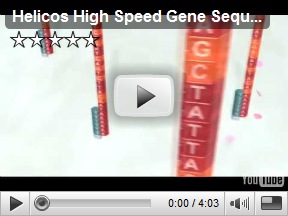Last year I was luck enough to spend a bit time talking with Dr. Patrice Milos, Chief Science Officer for Helicos who explained the entire process to me, an interesting read and in layman’s terms pretty much. One thing that the doctor and I both whole heartedly agreed on is that “it is all about  software”. Prior to Helicos, Dr. Milos had worked for Pfizer with the development of Lipitor.
software”. Prior to Helicos, Dr. Milos had worked for Pfizer with the development of Lipitor.
Helicos BioSciences and Personalized Medicine - Featured Interview with Dr. Patrice Milos
Personalized medicine will rely on IT – It’s all about Software
Sequencing cost are on their way down rapidly and soon it may be a regular part of clinical healthcare as we learn more about interpreting and how to build medicine based on the information and data compiled. The group wrote a sophisticated algorithm that would enable them to determine how accuracy and took one month to complete, time is getting a lot faster too. BD
STANFORD, Calif.--(BUSINESS WIRE)--The first few times that scientists mapped out all the DNA in a human being in 2001, each effort cost hundreds of millions of dollars and involved more than 250 people. Even last year, when the lowest reported cost was $250,000, genome sequencing still required almost 200 people. In a paper to be published online Aug. 9 by Nature Biotechnology, a Stanford University
professor reports sequencing his entire genome for less than $50,000 and with a team of just two other people.
In other words, a task that used to cost as much as a Boeing 747 airplane and required a team of people that would fill half the plane, now costs as much as a mid-priced luxury sedan and the personnel would fill only half of that car.
“This is the first demonstration that you don’t need a genome center to sequence a human genome,” said Stephen Quake, PhD, professor of bioengineering. “It’s really democratizing the fruits of the genome revolution and saying that anybody can play in this game.”
To sequence his genome, Quake’s team used a commercially available, refrigerator-sized instrument called the Helicos Biosciences SMS Heliscope. Quake, who pioneered the underlying technology in 2003, is a co-founder of the Cambridge, Mass.-based company and chairs its scientific advisory board.
Quake said the information has also forced him to take heed of that history. “If you know your uncle had something, you kind of discount that you can get it, but to see you’ve inherited the mutation for that is another matter altogether,” he said.
One amusing “revelation” is that Quake’s code contains a form of a gene that has sometimes been associated with increased disagreeability, he said. The details of the code can be found on the Web at http://www.snpedia.com/index.php/Rs6832769.
“Of course, you don’t need my genome to tell you that,” Quake acknowledged. “My wife could have told you that and certainly the dean could have as well.”
Funding for the research came from the National Science Foundation and from the National Institutes of Health.
Stanford Professor Sequences His Entire Genome at Low Cost, with Small Team
Related Reading:




nice blog and have lots of stuff here.........
ReplyDeletehttp://biotechnolo.blogspot.com